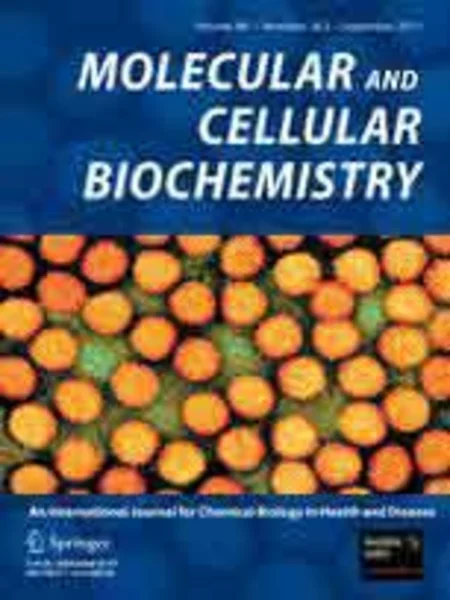-
lamp2 as a marker of ebv-mediated b lymphocyte transformation in the study of lysosomal storage diseases
جزئیات بیشتر مقاله- تاریخ ارائه: 1392/07/24
- تاریخ انتشار در تی پی بین: 1392/07/24
- تعداد بازدید: 1088
- تعداد پرسش و پاسخ ها: 0
- شماره تماس دبیرخانه رویداد: -
following the degradative pathway, vesicles loaded with extracellular material, eventually, dock and fuse with lysosomes, acquiring specific membrane markers of these organelles and acid hydrolases responsible for digest their content. the lysosomal-associated membrane protein 2 (lamp-2), the best characterized lysosomal membrane protein, is found in late stages of endosome maturation and may be used as a marker of lysosome-associated membranes. lysosomal storage disorders (lsds) are described by the absence or deficiency in hydrolase activity leading to substrate accumulation within lysosomal components and to the onset of several diseases. it is known that lymphocytes infected by epstein–barr virus (ebv) are able to form cytoplasmic vacuoles, which work as a storage compartment for lysosomal acidic hydrolases. at the present study, we validate the ebv as a transforming agent of b lymphocytes in stability studies of long-term stored samples, since the methods used to keep samples in liquid nitrogen and thaw them have all proven to be efficient in samples frozen for up to 2 years. to confirm and investigate some of the most prevalent lsds in the south of brazil—pompe, fabry and gaucher diseases—we first measured the enzymatic activity of α-glicosidase, α-galactosidase, and β-glicosidase in those cytoplasmic-formed vacuoles and then looked to lamp-2 immunoreactivity by employing confocal microscopy techniques.
مقالات جدیدترین رویدادها
-
استفاده از تحلیل اهمیت-عملکرد در ارائه الگوی مدیریت خلاقیت سازمانی و ارائه راهکار جهت بهبود
-
بررسی تاثیر ارزش وجوه نقد مازاد بر ساختار سرمایه شرکت های پذیرفته شده در بورس اوراق بهادار تهران
-
بررسی تأثیر سطح افشای ریسک بر قرارداد بدهی شرکت های پذیرفته شده در بورس اوراق بهادار تهران
-
بررسی تأثیر رتبه بندی اعتباری مبتنی بر مدل امتیاز بازار نوظهور بر نقد شوندگی سهام با تأکید بر خصوصی سازی شرکت ها
-
تأثیر آمیخته بازاریابی پوشاک ایرانی بر تصویر ذهنی مشتری پوشاک ایرانی (هاکوپیان)
-
ارائه سیستم یکپارچه مدیریت پایگاه داده در تعامل با مدل سازی اطلاعات ساختمان
-
طرح اختلاط بتن های سبکدانه با استفاده از مدل دوفازی
-
رابطه مؤلفه های شخصیت با افسردگی در دانشجویان علوم پزشکی
-
فناوری لوله های حرارتی با استفاده از نانوسیالات عامل، راهکار موثرتبادل حرارت و بهینه سازی مصرف انرژی
-
حاشیه های انجماد سریع و نقش آن ها در سیر تحولی گرانیتوئیدهای الیگودرز
مقالات جدیدترین ژورنال ها
-
مدیریت و بررسی افسردگی دانش آموزان دختر مقطع متوسطه دوم در دروان کرونا در شهرستان دزفول
-
مدیریت و بررسی خرد سیاسی در اندیشه ی فردوسی در ادب ایران
-
واکاوی و مدیریت توصیفی قلمدان(جاکلیدی)ضریح در موزه آستان قدس رضوی
-
بررسی تاثیر خلاقیت، دانش و انگیزه کارکنان بر پیشنهادات نوآورانه کارکنان ( مورد مطالعه: هتل های 3 و 4 ستاره استان کرمان)
-
بررسی تاثیر کیفیت سیستم های اطلاعاتی بر تصمیم گیری موفق در شرکتهای تولیدی استان اصفهان (مورد مطالعه: مدیران شرکتهای تولیدی استان اصفهان)
-
بررسی رابطه تناسب شغل - شاغل و رضایت شغلی با عملکرد شغلی کارکنان
-
نظام اداری ایران: تحلیلی بر مشکلات و چالش ها
-
مروری بر عوامل موثر جهت افزایش ایمنی و کاهش تصادفات در قوس ها
-
تاثیر جو سازمانی بر ابعاد مالی و غیر مالی عملکرد شعب مراکز استانی بانک توسعه صادرات ایران با استفاده از مدل ارزیابی مالتیک
-
the quintessential categories of the author’s time and literary time




سوال خود را در مورد این مقاله مطرح نمایید :